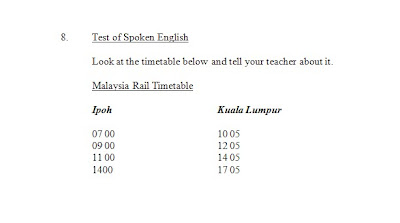Translate
Friday, 14 December 2012
Criteria for Evaluating Language Tests
In terms of validity, the items in the question 1 are valid because it test about grammar, which reflect on what it supposed to measure. The distractors are able to do their job. Students might answer b or d. However, it is not practical because the item are hard to construct. Test makers need to make sure that there is only one answer for each question to avoid argument regarding the answer. Therefore, the items are not reliable since there are two possible answers for the questions. Students may get negative washback effect because of the confusion while choosing the right answer. Question 2 is not practical because the item is ambiguous. Students might have several different answer. The items is not valid because it doesn't have specific purpose on testing students' language ability. To answer this question will consumes time because it needs a lot of thinking while arranging the dialogue.
Question number 3, it has content validity because it is about grammar and it measure what it supposed to measure.
Question number 4 is valid in term of content validity because it measure what it proposed to measure (vocabulary). However, the questions are to difficult for students, it will gives negative washback effect. Students will takes time to answer the questions, therefore it is not practical.
Question number 5 is seen as valid, reliable, practical and have positive washback effect. It is valid because the question clearly test about listening skills. It's reliable because the question is unambiguous, each questions only have one answer. For practicability, the question is easy to construct and conduct, and it does not consumes time to answer it. Teacher can use this test to enhance students' listening skills which gives positive washback effect. Question 6 is not valid because it does not measure communicative competence but the test is about grammar. Therefore, it doesn't measure what it proposed to measure. Question 7 is practical and reliable, it is easy to construct and conduct. But rubrics should be provided as marking or scoring guideline. Question 8 is ambiguous because the instruction is not clear. Students may speak anything about the timetable and not about the time in Ipoh and Kuala Lumpur.
Subscribe to:
Post Comments (Atom)






No comments:
Post a Comment